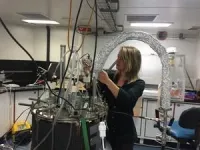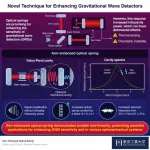(Press-News.org) A research group centered at the University of California San Diego School of Medicine has drilled deep into a dataset of over 3 million individuals compiled by the direct-to-consumer genetics company 23andMe, Inc., and found intriguing connections between genetic factors influencing alcohol consumption and their relationship with other disorders.
The study was recently published in the Lancet eBioMedicine.
Sandra Sanchez-Roige, Ph.D., corresponding author and associate professor at UC San Diego School of Medicine Department of Psychiatry, explained that the study used genetic data to broadly classify individuals as being European, Latin American and African American. Such classifications “are needed to avoid a statistical genetics pitfall called population stratification,” noted co-author Abraham A. Palmer, Ph.D., professor and vice chair for basic research in the psychiatry department.
The researchers analyzed genetic data from the 3 million 23andMe research participants, focusing on three specific little snippets of DNA known as single-nucleotide polymorphisms, or SNPs. Sanchez-Roige explained that variants, or alleles, of these particular SNPs are “protective” against a variety of alcohol behaviors, from excessive alcohol drinking to alcohol use disorder.
One of the alcohol-protective variants they considered is very rare: the most prevalent among the three alleles found in the study showed up in 232 individuals of the 2,619,939 European cohort, 29 of the 446,646 Latin American cohort and in 7 of the 146,776 African American cohort; others are much more common. These variants affect how the body metabolizes ethanol — the intoxicating chemical in alcoholic beverages.
“The people who have the minor allele variant of the SNP convert ethanol to acetaldehyde very rapidly. And that causes a lot of negative effects,” said Sanchez-Roige. She went on to say that the resulting nausea eclipses any pleasurable effects of alcohol — think of a bad hangover that sets in almost immediately.
“These variants are primarily associated with how much someone may consume alcohol,” she said. “And they also tend to prevent alcohol use disorder, because these variants are primarily associated with the quantity of alcohol someone may drink.”
Sanchez-Roige explained that the SNP variants’ influence on alcohol consumption are well researched, but her group took a “hypothesis-free” approach to the 23andMe dataset, which contains survey data on thousands of traits and behaviors. The researchers wanted to find out if the three SNP variants might have any other effects beyond alcohol consumption.
Sanchez-Roige and Palmer noted that their group has developed a 10-year partnership with 23andMe that has focused on numerous traits, especially those with relevance for addiction. This work is the basis of an academic collaboration through the 23andMe Research Program.
They data-mined the analyses of DNA from saliva samples submitted by consenting 23andMe research participants, as well as the responses to the surveys of health and behavior available from the 23andMe database, and found a constellation of associations, not necessarily connected with alcohol. Individuals with the alcohol-protecting alleles had generally better health, including less chronic fatigue and needing less daily assistance with daily tasks.
But the paper notes individuals with the alcohol-protective alleles also had worse health outcomes in certain areas: more lifetime tobacco use, more emotional eating, more Graves’ disease and hyperthyroidism. Individuals with the alcohol-protective alleles also reported totally unexpected differences, such as more malaria, more myopia and several cancers, particularly more skin cancer and lung cancer, and more migraine with aura.
Sanchez-Roige acknowledged that there is a chicken-and-egg aspect to their findings. For example: Cardiovascular disease is just one of a number of maladies known to be associated with alcohol consumption. “So is alcohol consumption leading to these conditions?” she asks. Palmer finishes the thought: “Or do these genetic differences influence traits like malaria and skin cancer in a manner that is independent of alcohol consumption?”
Sanchez-Roige said that such broad, hypothesis-free studies are only possible if researchers have access to very large sets of data. Many datasets, including the one used in the study, rely heavily on individuals with European ancestry.
“It is important to include individuals from different ancestral backgrounds in genetic studies because it provides a more complete understanding of the genetic basis of alcohol behaviors and other conditions, all of which contributes to a more inclusive and accurate understanding of human health,” she said. “The study of only one group of genetically similar individuals (for example, individuals of shared European ancestry) could worsen health disparities by aiding discoveries that will disproportionately benefit only that population.”
She said their study opens numerous doors for future research, chasing down possible connections between the alcohol-protective alleles and conditions that have no apparent connection with alcohol consumption.
“Understanding the underlying mechanisms of these effects could have implications for treatments and preventative medicine,” Sanchez-Roige noted.
Co-authors on the paper from the University of California San Diego School of Medicine Department of Psychiatry are Mariela V. Jennings, Natasia S. Courchesne-Krak, Renata B. Cupertino and Sevim B. Bianchi. Sandra Sanchez-Roige is also associated with the Department of Medicine, Division of Genetic Medicine, Vanderbilt University.
Other co-authors are: José Jaime Martínez-Magaña, Department of Psychiatry, Division of Human Genetics, Yale University School of Medicine; Laura Vilar-Ribó, Psychiatric Genetics Unit, Group of Psychiatry, Mental Health and Addiction, Vall d’Hebron Research Institute, Universitat Autònoma de Barcelona, Barcelona, Spain; Alexander S. Hatoum, Department of Psychology & Brain Sciences, Washington University in St. Louis; Elizabeth G. Atkinson, Department of Molecular and Human Genetics, Baylor College of Medicine; Paola Giusti-Rodriguez, Department of Psychiatry, University of Florida College of Medicine; Janitza L. Montalvo-Ortiz, Department of Psychiatry, Division of Human Genetics, Yale University School of Medicine, National Center of Posttraumatic Stress Disorder, VA CT Healthcare Center; Joel Gelernter, VA CT Healthcare Center, Department of Psychiatry, West Haven CT; and Departments of Psychiatry, Genetics & Neuroscience, Yale Univ. School of Medicine; María Soler Artigas, Psychiatric Genetics Unit, Group of Psychiatry, Mental Health and Addiction, Vall d’Hebron Research Institute, Universitat Autònoma de Barcelona, Barcelona, Spain; Department of Mental Health, Hospital Universitari Vall d’Hebron, Barcelona; Biomedical Network Research Centre on Mental Health (CIBERSAM), Madrid; and Department of Genetics, Microbiology, and Statistics, Faculty of Biology, Universitat de Barcelona; Howard J. Edenberg, Department of Biochemistry and Molecular Biology, Indiana University School of Medicine; and the 23andMe Inc. Research Team, including Sarah L. Elson and Pierre Fontanillas.
The study was funded, in part, by Tobacco-Related Disease Research Program grants T32IR5226 and 28IR-0070, National Institute of Health (NIH) National Institute of Drug Abuse (NIDA) DP1DA054394, and NIH National Institute of Mental Health (NIMH) R25MH081482.
END
A deep dive into the genetics of alcohol consumption
Exploration of 3 million records uncovers connections between gene variants governing alcohol use and many non-alcohol-related conditions
2024-04-05
ELSE PRESS RELEASES FROM THIS DATE:
CHEOPS detects a ‘‘rainbow’’ on an exoplanet
2024-04-05
The CHEOPS space telescope, whose scientific operations centre is based at the University of Geneva (UNIGE), is providing new information on the mysterious exoplanet WASP-76b. This ultra-hot giant is characterised by an asymmetry between the amount of light observed on its eastern terminator - the fictitious line that separates its night side from its day side - and that observed on its western terminator. This peculiarity is thought to be due to a ‘‘glory’’, a luminous phenomenon similar to a rainbow, which occurs if the light from the star - the ‘‘sun’’ around which the ...
UTSA joins consortium to create sustainable aviation hub in San Antonio
2024-04-05
(SAN ANTONIO, TEXAS) — UTSA has signed a memorandum of understanding (MOU) with the U.S. Department of Energy Advanced Research Projects Agency – Energy (ARPA-E), the City of San Antonio, and CPS Energy to develop and promote energy technologies that could potentially decarbonize the aviation sector. The ambitious project will pursue a range of research and development objectives, including sustainable aviation technologies, battery technologies and battery storage solutions, enhanced electric vehicle charging technologies and power-related technologies. The MOU will position San Antonio as an innovation center for these new energy solutions, accelerating their development ...
Kerr-enhanced optical spring for next-generation gravitational wave detectors
2024-04-05
The detection of gravitational waves stands as one of the most significant achievements in modern physics. In 2017, gravitational waves from the merger of a binary neutron star were detected for the first time which uncovered crucial information about our universe, from the origin of short gamma-ray bursts to the formation of heavy elements. However, detecting gravitational waves emerging from post-merger remnants has remained elusive due to their frequency range lying outside the range of modern gravitational wave detectors (GWDs). ...
Magnetic resonance imaging in prostate cancer screening
2024-04-05
About The Study: The results of this systematic review and meta-analysis suggest that integrating magnetic resonance imaging (MRI) in prostate cancer screening pathways is associated with a reduced number of unnecessary biopsies and overdiagnosis of insignificant prostate cancer while maintaining clinically significant prostate cancer detection as compared with prostate-specific antigen (PSA)-only screening.
Authors: Shahrokh F. Shariat, M.D., D.Dr.(hc), of Medical University Vienna in Vienna, is the corresponding author.
To access the embargoed study: Visit our For The Media website at this link https://media.jamanetwork.com/
(doi:10.1001/jamaoncol.2024.0734)
Editor’s ...
The sense of smell is influenced by cues from other senses
2024-04-05
The sense of smell is highly influenced by the cues from other senses, while the sense of sight and hearing are affected to a much lesser extent, shows a new study in Journal of Neuroscience.
A popular theory of the brain holds that its main function is to predict what will happen next, so it reacts mostly to unexpected events. Most research on this topic, called predictive coding, has only focused on what we see, but no one knows if the different senses, such as smell, work in the same way.
To figure out more about how smell relates to how we ...
RNA that doesn’t age
2024-04-05
Certain RNA molecules in the nerve cells in the brain last a life time without being renewed. Neuroscientists from Friedrich-Alexander-Universität Erlangen-Nürnberg (FAU) have now demonstrated that this is the case together with researchers from Germany, Austria and the USA. RNAs are generally short-lived molecules that are constantly reconstructed to adjust to environmental conditions. With their findings that have now been published in the journal Science, the research group hopes to decipher the complex aging process of the brain and gain a better understanding of related degenerative diseases.
Most cells in the human ...
Study finds many younger people from high income neighborhoods jumped the eligibility queue for COVID-19 vaccines in NYC
2024-04-05
Despite vaccine shortages, many younger people in New York City accessed vaccines ahead of schedule, particularly in high-income areas, according to new research at Columbia University Mailman School of Public Health. Low-income areas with high proportions of older people demonstrated lower coverage rates than wealthier areas in the first three months of vaccine rollout, and higher mortality over the year. The findings are published in the Journal of Urban Health.
“A vaccine program that prioritized those at greatest risk of COVID-19-associated morbidity and mortality would have prevented more deaths than the strategy that was implemented,” said Nina Schwalbe, adjunct ...
Rapid, simultaneous detection of multiple bacteria achieved with handheld sensor
2024-04-05
Hear the words E. coli or salmonella and food poisoning comes to mind. Rapid detection of such bacteria is crucial in preventing outbreaks of foodborne illness. While the usual practice is to take food samples to a laboratory to see the type and quantity of bacteria that forms in a petri dish over a span of days, an Osaka Metropolitan University research team has created a handheld device for quick on-site detection.
Led by Professor Hiroshi Shiigi of the Graduate School of Engineering, the team experimented with a biosensor that can simultaneously detect multiple disease-causing bacterial species within an hour.
“The palm-sized device for detection ...
Suicides among US college student athletes have doubled over past 20 years
2024-04-05
The number of suicides among US college student athletes has doubled over the past 20 years, finds an analysis of data from the National Collegiate Athletic Association (NCAA), published online in the British Journal of Sports Medicine.
Suicide is now the second most common cause of death after accidents in this group of young people, with rates highest among cross-country competitors, the findings show.
US suicide rates rose by around 36% across all age groups between 2001 and 2021, note the researchers. But the evidence ...
The Lancet: Prostate cancer cases expected to double worldwide between 2020 and 2040, new analysis suggests
2024-04-05
The Lancet: Prostate cancer cases expected to double worldwide between 2020 and 2040, new analysis suggests
Annual prostate cancer cases are projected to rise from 1.4 million in 2020 to 2.9 million in 2040, and annual deaths to increase by 85% to almost 700,000 over the same timeframe, mainly among men in low-and middle-income countries (LMICs).
The Lancet Commission on prostate cancer argues that the ‘informed choice’ programme for prostate cancer screening with PSA testing, which is common in high-income countries ...
LAST 30 PRESS RELEASES:
Do hormones explain why women experience more gut pain?
New materials conduct ions in solids as easily as in liquids
Breakthrough of the Year: Renewable energy begins to eclipse fossil fuel-based sources
LLM use is reshaping scientific enterprise by increasing output, reducing quality and more
Introducing LightGen, a chip for ultra-fast, ultra-efficient generative AI
Astronomers see fireworks from violent collisions around nearby star
ACC/AHA issue new guideline on managing congenital heart disease in adults
Cosmic crash caught on camera
Is talented youth nurtured the wrong way? New study shows: top performers develop differently than assumed
Ants: An untapped resource in the development of antibiotics?
Archaeologists use AI to create prehistoric video game
Mitochondria migrate toward the cell membrane in response to high glucose levels
Tiny viral switch offers hope against drug-resistant bacteria
Most parents aware of early peanut introduction guidelines, but confused about details
HPV vaccine can protect against severe lesions of the vulva and vagina
Virtual care provision and emergency department use among children and youth
Quadrivalent HPV vaccine and high-grade vulvovaginal lesions
Insights into dry eyes gained from stem cell-derived tear glands
Researchers identify 166 human pluripotent stem cell lines available for use in clinical applications
Europa Clipper instrument uniquely observed interstellar comet 3I/ATLAS
UN University Report challenges climate change as sole trigger of Syrian Civil War, exposing governance failures in drought response
Real estate investment trust (REIT) acquisition associated with hospital closure and bankruptcy
New Raman imaging system detects subtle tumor signals
Boston Children’s receives a $7.5 million grant from Aligning Research to Impact Autism (ARIA) to provide clinical research coordination for the IMPACT Network
Spray-on antibacterial coating offers new protection for plants against disease and drought
ESMT Berlin study: What makes a first offer successful in negotiations
Groundbreaking ceremony marks the beginning of CTAO-South Array construction in Chile
Why swearing makes you stronger
What prevents more cancer patients from enrolling in potentially life-saving clinical trials?
UK’s worst-case climate risks laid bare for lawmakers
[Press-News.org] A deep dive into the genetics of alcohol consumptionExploration of 3 million records uncovers connections between gene variants governing alcohol use and many non-alcohol-related conditions






